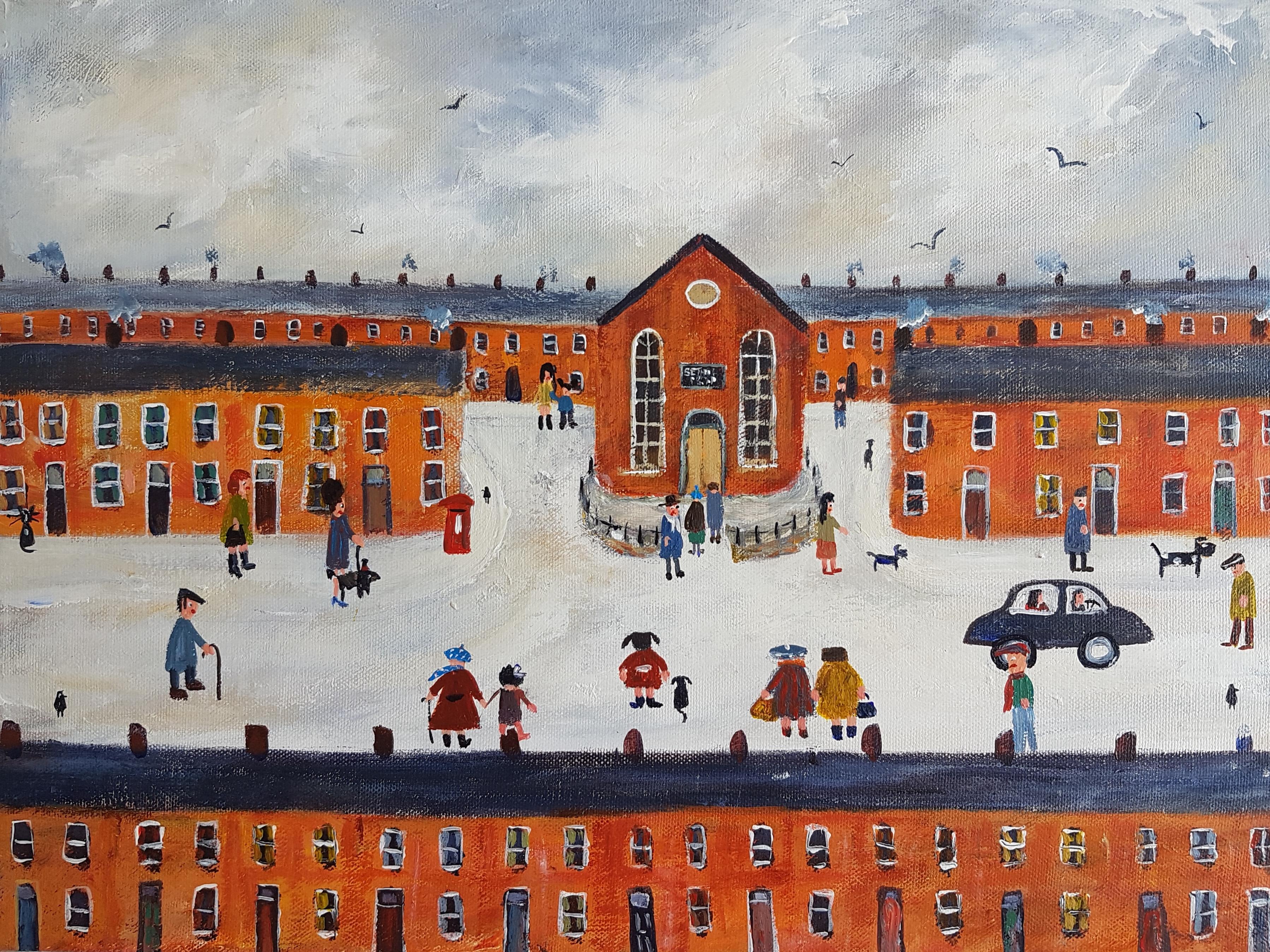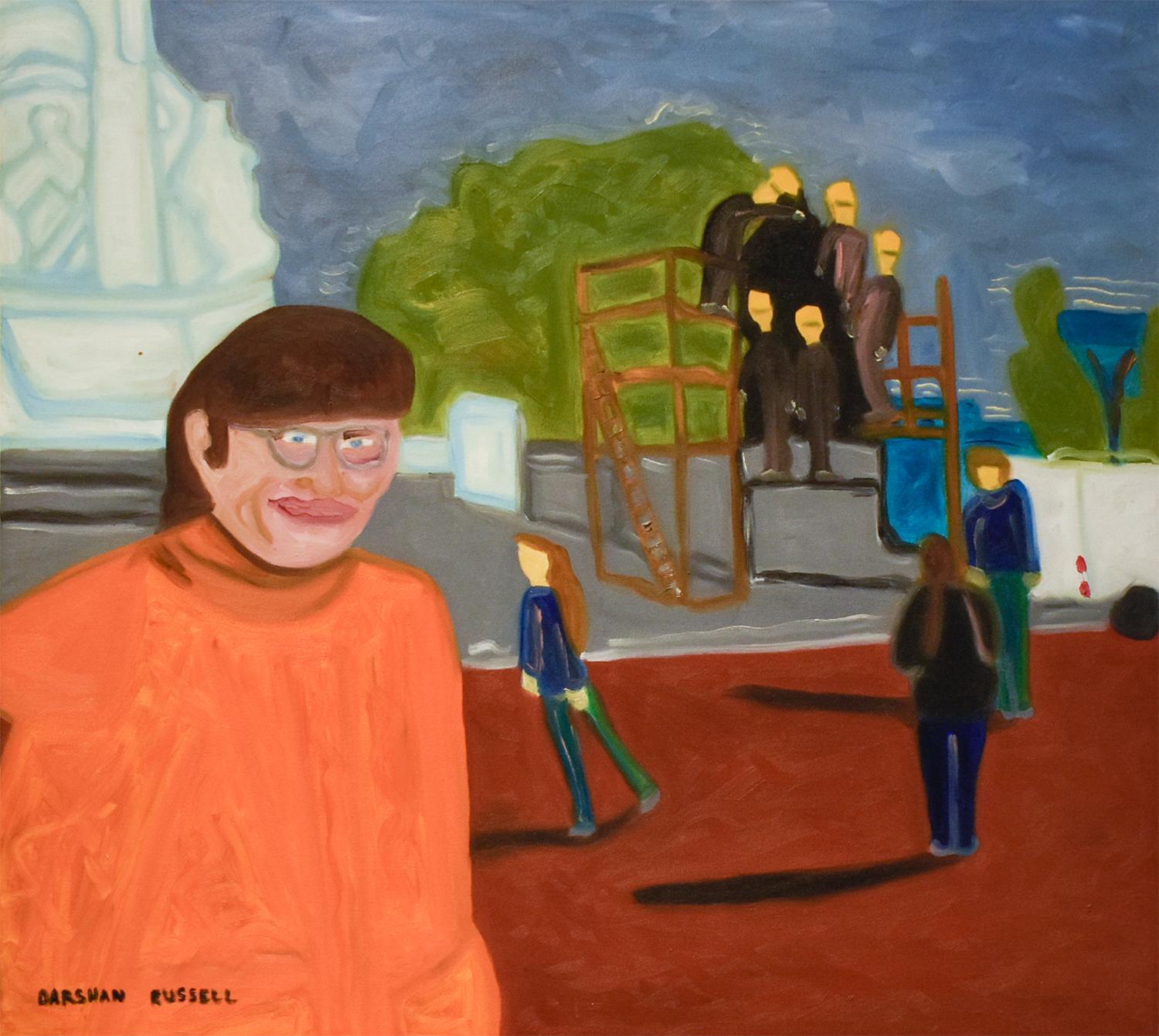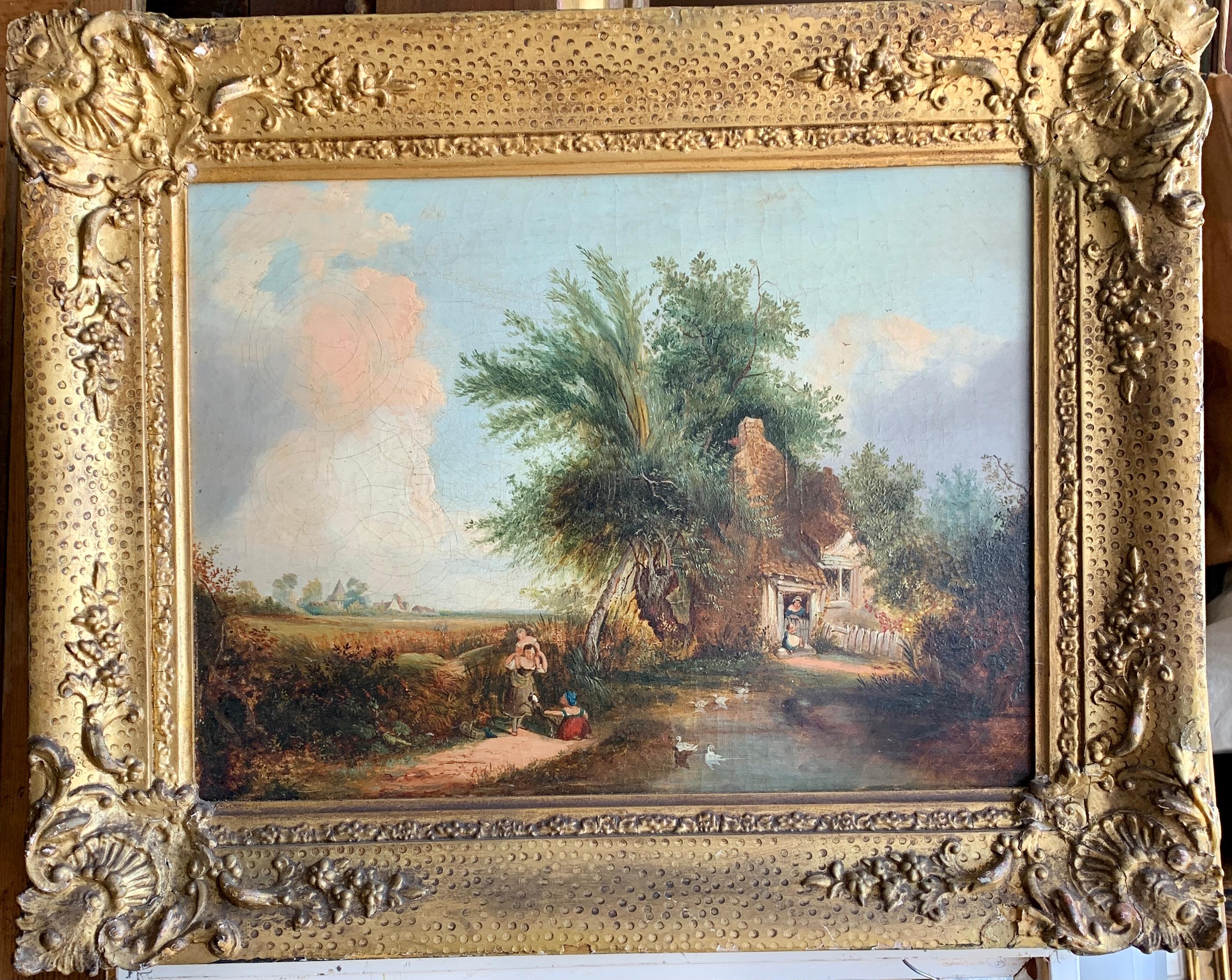Items Similar to Charming Vintage 1970s French Naive Paris Street Scene Folk Art Style Painting
Want more images or videos?
Request additional images or videos from the seller
1 of 10
UnknownCharming Vintage 1970s French Naive Paris Street Scene Folk Art Style Paintingc.1970s
c.1970s
About the Item
in the manner of Michel Delacroix, A charming French Naif cityscape painting depicting a lively Parisian corner with a trolley, a clown with balloon, children playing and a news kiosque. Done in a whimsical. naive, folk art style. I am not sure if it is an oil painting or an acrylic painting. It is hand signed, illegibly, lower right.
About the Seller
4.9
Platinum Seller
These expertly vetted sellers are 1stDibs' most experienced sellers and are rated highest by our customers.
Established in 1995
1stDibs seller since 2014
1,547 sales on 1stDibs
Typical response time: 1 hour
- ShippingRetrieving quote...Ships From: Surfside, FL
- Return PolicyA return for this item may be initiated within 3 days of delivery.
More From This SellerView All
- Naive London Street Scene Folk Art Oil Painting Big Ben, Parliament, Union JackBy Andrew MurrayLocated in Surfside, FLBig Ben, House of Parliament with Union Jack flag, Thames River, boats, barges, airplane and double decker red bus. Classic London street scene. 24 inches by 11 inches in a frame 24.5 inches by 11.5 inches. ANDREW MURRAY became known and loved as an imaginative Naive painter who captured the character of cities (especially Cape Town and London) with humorous and affectionate insight. An English counterpart to Michel Delacroix of Paris and Charles Fazzino of New York He was born in north China, the son of a missionary. As a child of five he had his first lesson in painting from the son of another, the 10-year- old Mervyn Peake...Category
20th Century Folk Art Figurative Paintings
MaterialsCanvas, Oil
- French Folk Art Naive Oil Painting Workers in Vineyard, Les Vignes aux GitansLocated in Surfside, FLMax Savy Oil on canvas painting depicting a village scene with winemakers in a vineyard by artist Max Savy (French, b. 1918). Signed in the lower right. Frame measures 24.5 inches x 28 inches. canvas is 18 X 22 inches., Perfect for a wine cellar or cave. Max Savy (French, 1918-2010) painted scenes of everyday life in the French Corbieres region, which garnered much success during his life. Though the artist remained silent about his early life, it's known his father instilled in him a belief in the humanist socialism philosophy of French Socialist Party leader, Jean Jaures. In 1938, at age 20, he moved to Carcassonne to attend school. There, he married and settled into a teaching position, joining the French Resistance during World War II and earning the Cross of the Combatant. After the war, he created the work for which he is most admired. Max Savy paintings are part of France's heritage collection, and the artist became a knight of the National Order of Merit in 1973. Max Savy's paintings and artworks include scenes of peasants in the fields. Max Savy was active/lived in France. Max Savy is known for folk art style painting of village architecture, vintners, figures in landscape, wine makers, marine scenes. His work is similar in style to the naive, folk art paintings of Michel Delacroix and Fanch Ledan. This is quite similar to a work I had titled "Les Vignes Aux Gitans" (the gypsy grape vines) So i assume this is also a vineyard painting...Category
Mid-20th Century Folk Art Landscape Paintings
MaterialsCanvas, Oil
- Fantastic Village Scene Modern Irish Magic Realism Oil PaintingBy Philip CastleLocated in Surfside, FLPhilip Castle was an Irish Painter and husband to artist Barry Castle He is rarely exhibited. His detailed, meticulous work took a long time to complete...Category
20th Century Folk Art Landscape Paintings
MaterialsCanvas, Oil
- Magic Realist Surrealist Latin American Naive Fantasy PaintingBy German Ramon Duron LanzaLocated in Surfside, FLMagic realist fantasy painting in the manner of Ernst Fuchs and Arik Brauer. Naïve art is any form of visual art that is created by a person who lacks the formal education and training that a professional artist undergoes (in anatomy, art history, technique, perspective, ways of seeing). Unlike folk art, naïve art does not necessarily evince a distinct cultural context or tradition. Naïve art is recognized, and often imitated, for its childlike simplicity and frankness. Paintings of this kind typically have a flat rendering style with a rudimentary expression of perspective. One particularly influential painter of "naïve art" was Henri Rousseau (1844–1910), a French Post-Impressionist who was discovered by Pablo Picasso. Naïve art is often seen as outsider art that is by someone without formal (or little) training or degree. While this was true before the twentieth century, there are now academies for naïve art. Naïve art is now a fully recognized art genre, represented in art galleries worldwide. Museums devoted to naïve art now exist in Kecskemét, Hungary; Riga, Latvia; Jaen, Spain; Rio de Janeiro, Brasil; Vicq France and Paris. "Primitive art" is another term often applied to art by those without formal training, but is historically more often applied to work from certain cultures that have been judged socially or technologically "primitive" by Western academia, such as Native American, sub saharan African or Pacific Island art (see Tribal art). This is distinguished from the self-conscious, "primitive" inspired movement primitivism. Another term related to (but not completely synonymous with) naïve art is folk art. There also exist the terms "naïvism" and "primitivism" which are usually applied to professional painters working in the style of naïve art (like Paul Gauguin, Mikhail Larionov, Paul Klee). At all events, naive art can be regarded as having occupied an "official" position in the annals of twentieth-century art since - at the very latest - the publication of the Der Blaue Reiter, an almanac in 1912. Wassily Kandinsky and Franz Marc, who brought out the almanac, presented 6 reproductions of paintings by le Douanier' Rousseau (Henri Rousseau), comparing them with other pictorial examples. However, most experts agree that the year that naive art was "discovered" was 1885, when the painter Paul Signac became aware of the talents of Henri Rousseau and set about organizing exhibitions of his work in a number of prestigious galleries. The Earth Group (Grupa Zemlja) were Croatian artists, architects and intellectuals active in Zagreb from 1929 to 1935. The group included the painters Krsto Hegedušić, Edo Kovačević, Omer Mujadžić, Kamilo Ružička, Ivan Tabaković, and Oton Postružnik, the sculptors Antun Augustinčić, Frano Kršinić, and the architect Drago Ibler. A term applied to Yugoslav (Croatian) naive painters working in or around the village of Hlebine, near the Hungarian border, from about 1930. Some of the best known naive artists are Dragan Gaži, Ivan Generalić, Josip Generalić, Krsto Hegedušić, Mijo Kovačić, Ivan Lacković-Croata, Franjo Mraz, Ivan Večenaj and Mirko Virius. Camille Bombois (1883–1970) Ferdinand Cheval, known as 'le facteur Cheval' (1836–1924) Henry Darger (1892–1973) L. S. Lowry (1887–1976) Grandma Moses, Anna Mary Robertson (1860–1961) Nikifor (1895–1968) Poland, Horace Pippin (1888–1946) Jon Serl (1894-1993) United States Alfred Wallis (1855–1942) Scottie Wilson (1890–1972) Gesner Abelard (b. 1922) Jan Balet (1913–2009) Michel Delacroix (b. 1933) France Howard Finster (1916–2001) Ivan Rabuzin (1921–2008) Spontaneous Art Museum in Brussels Art en Marge Museum in Brussels MADmusée in Liege International Museum of Naive Art of Brazil in Cosme Velho, Rio de Janeiro Gallery Jacques Ardies in São Paulo Musée international d'art naïf de Magog in Magog Croatian Museum of Naïve Art in Zagreb Gallery of Croatian Naïve Art...Category
20th Century Folk Art Figurative Paintings
MaterialsCanvas, Acrylic
- Large Israeli Naive Art Screen Enamel Oil Painting Jerusalem Old City Folk ArtBy Gabriel CohenLocated in Surfside, FLJERUSALEM, Vielle du David, (City of David) Superlac (enamel) painting on paper, hand signed, titled and dated. Provenance: Michael Hittleman Gallery Los Angeles. Gabriel Cohen, (French-Israeli) Self taught, Naive painter was born in Paris in 1933, to parents from Jerusalem with a father who studied the kabbalah. Throughout World War II, the family hid from the Nazis in Paris. Images of Nazi soldiers appear in several of his paintings. In 1949, when Gabriel was 16, the family returned to Israel. They managed to save enough money to move back to the quarter where both parents were born: Ohel Moshe in Nachlaot. Gabriel served in the artillery corps and after the army, went back to live in his parents' house and earned a living polishing diamonds. The head of the polishing plant, who noticed his employee's artistic skill, allowed him to paint during work hours. He once asked Cohen if he could draw a tiger. Cohen drew him a tiger. And he did a lot of sculpting and painting on glass. He also loved to play the guitar, especially flamenco style. Critics say he is one of Israel's greatest naive-style painters. Along with Shalom of Safed, Kopel Gurwin and Natan Heber, He is renowned as one of Israel's greatest living naive-style folk art painters, recipient of the Jerusalem Prize for Art (1987), a permanent entry in encyclopedias of naive painting, who exhibited his work not only in Israel, but also in Paris, Venezuela, Denmark and Germany; the same Gabriel Cohen whose colorful , bold Naif paintings were exhibited at the Jewish Museum in New York in 1987 alongside works by Marc Chagall; the same Gabriel Cohen about whom curator and art scholar Gideon Ofrat says, "There is no questioning his greatness." He has shown in Paris on the Rue de Rosiers in the Marais. His impressions of his journeys, mostly imaginary, yet some real, are expressed in Cohen's paintings. Huge, colorful canvases rich in precise detail and fantasy, in which he paints the Eiffel Tower and the Russian steppes or the vistas of Paris and the Tower of Babel "In my opinion, it's also because the Tower of Babel has some kind of phallic, erotic meaning, but also because of the internationalism, of the mixture and confusion of nations, which is an essential element in Gabi Cohen's work," says Gideon Ofrat. There is no superlative that has not been lavished on Cohen's work by art critics, since he began showing his paintings at age 40, All the art critics seemed to agree at once that Cohen is one of the greatest naive-style painters in Israel. Their counterparts abroad seconded this view. About a year and a half ago, Zadka organized a show for Cohen at the Jerusalem Artists' House. The Tel Aviv Museum bought a painting of Gabi's and so did the Israel Museum, and several artists bought his drawings. He is a great, great painter. There is no painter who is more of a symbolist and illustrative artist than he is. As a painter myself, I admire him." The Yom Kippur War in 1973 sparked an artistic breakthrough for Cohen; it was at that time that he began to sit on the sidewalk after his work as a diamond polisher and paint. Not long afterward, in early 1974, he did a painting he called "Moses on the Mountain." Ruth Debel, of the Debel Gallery in Ein Kerem, passed by and saw it on the street. She asked how much he wanted for it, and for the first time in his life, he realized that his work had financial value. His first show was at the Debel Gallery in 1974. The response was overwhelming. Cohen was immediately declared a genius. His paintings at the gallery were purchased and he continued to create new paintings. That same year, he was invited to take part in a group exhibition of naive artists at the Kunsthaus in Zurich, and a year later, his work was included in a traveling show of naive-style artists from Israel that was exhibited in Denmark and Germany. Soon after that he was invited to be part of group shows in Venezuela and at the Tel Aviv Museum. Cohen had four solo shows at the Debel Gallery. Awards And Prizes 1987 Jerusalem Prize for Painting and Sculpture 1999 Shoshana Ish-Shalom Prize for special contribution to art, Jerusalem He has exhibited alongside all of the Israeli great artists. included in the Naive Art Group exhibition Gvanim Art Gallery, Jerusalem Rubin, Rachel Roman, Yitzhak Zarembo, Leah Moscovitz, Shalom (of Safed) Steinberg, Michael Denisov, Salva Harbon, Haim Cohen, Gabriel Chanannia, Joseph (Jojo) Local Hero...Category
20th Century Folk Art Landscape Paintings
MaterialsPaper, Oil, Alkyd
- Modernist Family Outing with Dog (Picnic in the Park) Ben Benn Oil Painting WPABy Ben BennLocated in Surfside, FLGenre: Modern Subject: People Medium: Acrylic Surface: Canvas Country: United States Dimensions: 20" x 24" Scene of a family leisurely gathering together in a park to picnic and enjoying their day by the artist Ben Benn. Ben Benn, Russian/American (1884-1983) Ben Benn, a Russian-born American still-life and Post Impressionist landscape painter who was part of the first generation of artists in America to try to digest the lessons of Cubism Benn Benn was a pioneer American modernist whose independent style defied stylistic classification. Despite excursions into Cubism and Abstract Expressionist style, Benn “seems always to have been a ‘subject’ painter. Considering this, it is remarkable that he remained visible at all during the 50’s and early 60’s, when prejudice against the representational amounted nearly to a proscription of it.” Benn’s prominence in the art world over 6 decades was reaffirmed at a 90th birthday show at the Hirshhorn Museum in Washington , D.C. in 1974. Benn was born Benjamin Rosenberg in the town of Kamenets Podolsk in the Russian empire in 1884. This town was the regional capital of an area in what is today, SW Ukraine, and was historically known as Podolia. the Rosenberg family chose, along with thousands of others, to immigrate from Podolia to the United States in 1894 or 1899. “Between 1904 and 1908 Benn attended the National Academy of Design and he studied at the Arts Students League In New York City. He spent most of his career in New York City including memberships with the American Society of Painters and Sculptors, American Artists Congress and the Woodstock Artist Association. Academy curriculum stressed portraiture built up with broad, painterly brushstrokes, a technique that remained the foundation of Benn’s style. In his first group show, in 1913, he exhibited with Max Weber and Man Ray. By the mid teens his canvases were bolder in color and more decorative in style. In 1916, Benn participated in the important "Forum Exhibition of Modern American Painters...Category
Mid-20th Century Expressionist Figurative Paintings
MaterialsCanvas, Oil
You May Also Like
- Sunday Song, Naive School PaintingBy Therese JamesLocated in Brecon, PowysTraditions are important in Wales. This painting from Therese takes a peek at the Sunday morning outing to chapel. Wearing their Sunday best the villagers head out and catch up on al...Category
21st Century and Contemporary Outsider Art Landscape Paintings
MaterialsCanvas, Acrylic
- Blowing The Cobwebs Away. Contemporary Figurative PaintingBy Therese JamesLocated in Brecon, PowysAcrylic on canvas, signed and framedCategory
2010s Outsider Art Figurative Paintings
MaterialsAcrylic, Canvas
- The Moment We Knew. Contemporary Figurative PaintingBy Therese JamesLocated in Brecon, PowysAcrylic on canvas, signed and framed Image 16" x 16". Framed 18" x 18"Category
2010s Outsider Art Figurative Paintings
MaterialsCanvas, Acrylic
- Self Portrait (Colorful Faux-Naif Figurative Cityscape Oil Painting)By Darshan RussellLocated in Hudson, NYColorful Faux Naive Style Cityscape Painting, Portrait of the Artist 'Self Portrait' painted by Darshan Russell in 1997 Oil on canvas, 21.5 x 24 inches framed with thin wood strippin...Category
1990s Outsider Art Landscape Paintings
MaterialsCanvas, Oil
- Parked Cars: Modern, Naive Style Square Oil Painting of Cars in a Gray LotBy Darshan RussellLocated in Hudson, NYOil on board 19 x 19 inches in dark brown wood frame 18 x 18 inches unframed This modern, abstracted naive style oil painting was made by Poughkeepsie, NY based artist Darshan Russe...Category
2010s Folk Art Landscape Paintings
MaterialsCanvas, Oil
- 19th century English Folk Art Cottage landscape with figures playing by a pondLocated in Woodbury, CTA very well painted classic English Folk art painting of figured playing by the pond with ducks and a rural cottage. This style of painting would Im sure have been painted by a cou...Category
1840s Folk Art Landscape Paintings
MaterialsCanvas, Oil
Recently Viewed
View AllMore Ways To Browse
Vintage Art Style
French Vintage Art
France Vintage Art
Retro Paris Style
Paris France Vintage
Vintage Art Paris France
Vintage Paris Style
Vintage Childrens Art
Paris Am
Vintage Art Of Children
Vintage 1970s Paris
Vintage Children Playing
Children Playing Vintage
Vintage Street Style
Painting Of Paris Cityscape
Naive Folk
Retro Cityscape Painting
Paris Cityscape Paintings





